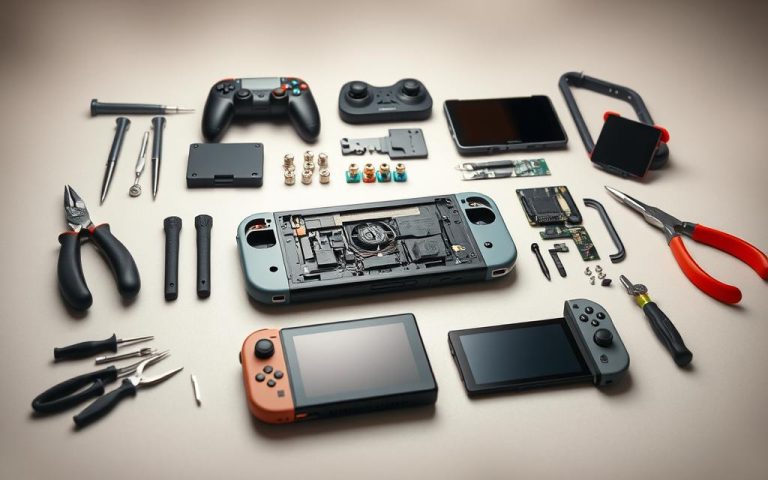Addressing Nintendo Switch Frame Rate Drops: Repair Tips
If you’re experiencing frame rate drops on your Nintendo Switch, don’t fret! There are simple and effective repair tips that can help you improve your gaming experience. Whether you’re battling lag or struggling with gameplay, these tips will assist you in resolving any frame rate issues.
Many games on the Nintendo Switch are limited to a frame rate of 30 FPS, but with the right adjustments, you can enhance the performance and enjoy smoother gameplay. From optimizing system settings to tweaking game configurations, there are various steps you can take to address frame rate drops. Let’s dive in and explore these repair tips in detail.
Moving System Data to the microSD Card
You can improve the performance of your Nintendo Switch games by moving your system data to the microSD card. This can help your games run more smoothly and reduce frame rate drops. To do this, follow these steps:
- Go to the “System Settings” menu on your Nintendo Switch.
- Select “Data Management” from the menu.
- Choose the “Move Data Between System/microSD Card” option.
This will prompt you to select which data you want to move to the microSD card. Simply follow the on-screen instructions to complete the process.
Moving your system data to the microSD card frees up space on the internal storage of your Nintendo Switch, allowing the system to run more efficiently. By doing so, you can improve the performance of your games and reduce the occurrence of frame rate drops.
Optimizing Controller Settings
Adjusting certain controller settings can greatly improve the frame rate on your Nintendo Switch. By making a few simple adjustments, you can enhance your overall gameplay experience and reduce any delays or lag. Here are some tips to optimize your controller settings:
Turn Off Controller Vibration
Controller vibration can be a fun feature, but it can also put additional strain on your system and potentially lead to frame rate drops. To mitigate this, navigate to the “Controllers and Sensors” menu in your System Settings and disable controller vibration.
Set Resolution to the Highest Setting
Your Nintendo Switch allows you to adjust the resolution of your games. Increasing the resolution to the highest possible setting can enhance the visual quality and improve the frame rate. Head to the display settings and select the maximum resolution supported by your device.
Switch to RGB Full Range
RGB settings determine the range and quality of colors displayed on your Nintendo Switch. Switching to the “Full Range” setting can enhance the vibrancy and clarity of visuals, thus improving your gaming experience. Locate the RGB settings in your display options and select the “Full Range” option.
Prevent Your Switch from Falling Asleep
Frequent wake-ups from sleep mode can cause delays in gameplay. To prevent this, it’s recommended to set your Nintendo Switch to never fall asleep. This ensures a consistent and uninterrupted gaming session, reducing any potential interruptions during gameplay.
By optimizing your controller settings, you can enhance the frame rate and overall performance of your Nintendo Switch games. Experiment with these adjustments to find the configuration that suits your preferences and enjoy a smoother gaming experience.
Enhancing Game Settings
Tweaking certain game settings can have a positive impact on the frame rate of specific games. By optimizing various options, you can enhance your gameplay experience on the Nintendo Switch. These settings allow you to personalize your gaming environment and improve performance. Here are some key game settings to consider:
Colour Blind Settings
Leaving the colour blind settings as-is is generally advised to reduce strain on the system. These settings are designed to provide visual accessibility for players with colour vision deficiencies. By enabling them, you can ensure an inclusive gameplay experience for all users.
High-Resolution Textures
To prevent laggy in-game experiences, it’s recommended to enable the “Auto Download High Resolution Textures” option. This setting allows the game to utilize high-quality textures, enhancing the overall visual presentation. However, keep in mind that enabling this option may require additional storage space on your Nintendo Switch.
Matchmaking Region
Choosing the correct matchmaking region is crucial for optimizing online gameplay. By selecting the region closest to your geographical location, you can minimize latency issues and reduce gameplay lag. This ensures smoother multiplayer experiences and faster response times.
HUD Scale
Adjusting the HUD (Heads-Up Display) scale can greatly impact your gaming experience. It allows you to customize the size and visibility of in-game elements such as health bars, ammo counters, and minimaps. Adjusting the scale to a range of 60-80% can optimize the display without obstructing important gameplay information.
Subtitle Settings
Scaling down the subtitle settings can improve gameplay performance, especially during intense action sequences or dialogue-heavy moments. By reducing the size or number of subtitles displayed, you can increase frame rates and ensure a smooth gaming experience.
Experimenting with these game settings can help you find the optimal configuration for your Nintendo Switch games, enhancing both visuals and performance. Remember to adjust them according to your personal preferences and the requirements of each game.
| Setting | Description |
|---|---|
| Colour Blind Settings | Enable this option to provide visual accessibility for players with colour vision deficiencies. |
| High-Resolution Textures | Enable the “Auto Download High Resolution Textures” option to utilize high-quality textures for improved visual presentation. |
| Matchmaking Region | Select the region closest to your geographical location to minimize latency and reduce gameplay lag during online matches. |
| HUD Scale | Adjust the scale of the Heads-Up Display (HUD) to customize the size and visibility of in-game elements. |
| Subtitle Settings | Scale down subtitle settings to optimize gameplay performance during action sequences or dialogue-heavy moments. |
Disabling Unnecessary Settings
When it comes to optimizing the frame rate on your Nintendo Switch, disabling unnecessary settings can make a noticeable difference. By turning off certain features in your gameplay, you can provide a slight boost to the overall performance. Here are some settings you can consider disabling:
- Pre-Edit Option in Building Settings: The pre-edit option allows you to edit structures before placing them in the game. However, disabling this feature can help reduce lag and improve the frame rate during intense gameplay.
- Contextual Tips in Tutorial Settings: While the tutorial settings provide helpful tips and guidance during gameplay, disabling contextual tips can streamline the experience and enhance performance by reducing unnecessary pop-ups.
Additionally, adjusting visual settings in the “HUD Options” menu can further optimize gameplay performance. Consider turning off the following:
- Spectator Count
- Player Health
- Resources
- Minimap
Disabling these visual settings can help reduce clutter on the screen and improve the overall frame rate. Experiment with these settings to find the configuration that works best for your gaming preferences.
“Disabling unnecessary settings can provide a slight boost to the frame rate on your Nintendo Switch, improving your overall gaming experience.” – Nintendo Switch Pro Player
Optimizing Gameplay Performance
To further optimize gameplay performance, it’s essential to fine-tune various settings. In addition to disabling unnecessary features, adjusting controller settings, enhancing game settings, and improving your internet connection can all contribute to a smoother gaming experience. Find the right balance that suits your playstyle and enjoy the full potential of your Nintendo Switch.
| Setting | Impact |
|---|---|
| Controller Vibration | Turning off controller vibration can reduce input lag and improve responsiveness. |
| Resolution | Setting your resolution to the highest possible setting can enhance visual quality but may result in a slightly lower frame rate. |
| RGB Settings | Switching your RGB settings to “Full Range” can improve color accuracy and visual fidelity. |
| Switch Sleep Mode | Setting your Switch to never fall asleep can prevent unnecessary delays caused by device waking. |
Improving Internet Connection
A stable and fast internet connection is vital for optimal Nintendo Switch gameplay. To ensure smooth and uninterrupted gaming sessions, follow these tips to improve your internet connection:
- Connect to a Reliable WiFi Network: Make sure your Nintendo Switch is connected to a strong and stable WiFi network. If you experience frequent disconnections or slow speeds, consider upgrading your router or contacting your internet service provider for assistance.
- Increase Internet Speed: If you notice lag or delays while playing online games, it may be due to a slow internet speed. Contact your internet service provider to inquire about upgrading your internet plan for faster speeds.
- Boost WiFi Signal: If you’re experiencing weak WiFi signals, try moving your router to a more central location in your home. Additionally, avoid placing the router near any large electronic devices or metal objects that could interfere with the signal.
- Use a Wired Ethernet Connection: For the most stable and reliable connection, consider using a wired Ethernet connection instead of relying solely on WiFi. This can help eliminate lag and improve overall frame rate performance.
By following these tips, you can ensure a strong and stable internet connection for your Nintendo Switch, enhancing your gaming experience and minimizing interruptions.
“The key to smooth gameplay on the Nintendo Switch lies in a reliable internet connection.” – Nintendo Support
Internet Connection Troubleshooting
If you’re still experiencing issues with your internet connection, try the following troubleshooting steps:
- Restart your router and Nintendo Switch to refresh the connection.
- Check for any firmware updates for your router and install them if available.
- Disconnect any other devices connected to your WiFi network that may be consuming bandwidth.
- Temporarily disable any VPN or proxy services that might be affecting your connection.
- Contact your internet service provider for further assistance if the issues persist.
By following these troubleshooting steps, you can diagnose and resolve any issues that may be impacting your Nintendo Switch’s internet connection.
| Issue | Possible Solution |
|---|---|
| Slow internet speed | Contact your internet service provider to upgrade your plan for faster speeds |
| Frequent disconnections | Upgrade your router or contact your internet service provider for assistance |
| Weak WiFi signal | Move your router to a more central location and avoid interference from nearby devices or objects |
| Lag and delays in online games | Consider using a wired Ethernet connection for a more stable connection |
Remember, a strong and fast internet connection is essential for optimal Nintendo Switch gameplay. Invest in your internet quality to ensure a seamless gaming experience.
Conclusion
By following these repair tips, you can address frame rate drops on your Nintendo Switch and enhance your gaming experience. Adjusting system, controller, and game settings, as well as improving your internet connection, can significantly improve frame rates and reduce gameplay lag. Experiment with these tips to find the settings that work best for you and enjoy smooth and uninterrupted gaming sessions on your Nintendo Switch.
FAQ
How can I improve the frame rate on my Nintendo Switch?
There are several tips and tricks you can try to enhance the frame rate on your Nintendo Switch and resolve any gameplay lag. These include moving your system data to the microSD card, adjusting controller settings, optimizing game settings, disabling unnecessary settings, and improving your internet connection.
How do I move my system data to the microSD card?
To move your system data to the microSD card, go to the “Data Management” section of your System Settings and select the “Move Data Between System/microSD Card” option. This can help your games run more smoothly and reduce frame rate drops.
How can adjusting controller settings improve the frame rate on my Nintendo Switch?
Turning off controller vibration in the “Controllers and Sensors” menu of your System Settings can improve the frame rate on your Nintendo Switch. Additionally, setting your resolution to the highest possible setting and switching your RGB settings to “Full Range” can enhance the overall gameplay experience.
What game settings should I tweak to improve the frame rate?
Tweaking certain game settings can have a positive impact on the frame rate. Leaving the “Color Blind” settings as-is is generally advised to reduce strain on the system. Enabling the “Auto Download High Resolution Textures” option can prevent laggy in-game experiences. Choosing the correct matchmaking region, adjusting the HUD scale to a range of 60-80%, and scaling down subtitle settings can also optimize gameplay performance.
Are there any unnecessary settings I should disable in my gameplay?
Disabling unnecessary settings in your gameplay can provide a slight boost to the frame rate. Consider turning off features like the pre-edit option in building settings and contextual tips in tutorial settings. Additionally, turning off visual settings in the “HUD Options” menu, such as spectator count, player health, resources, and minimap, can further optimize gameplay performance.
How can I improve my internet connection for optimal Nintendo Switch gameplay?
A stable and fast internet connection is vital for optimal Nintendo Switch gameplay. Make sure your Switch is connected to a reliable WiFi network and consider increasing your internet speed if necessary. Boosting your WiFi signal or using a wired Ethernet connection can also help eliminate lag and improve frame rate performance.
How can I address frame rate drops on my Nintendo Switch?
By following these repair tips, you can address frame rate drops on your Nintendo Switch and enhance your gaming experience. Adjusting system, controller, and game settings, as well as improving your internet connection, can significantly improve frame rates and reduce gameplay lag. Experiment with these tips to find the settings that work best for you and enjoy smooth and uninterrupted gaming sessions on your Nintendo Switch.












